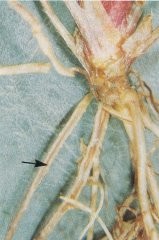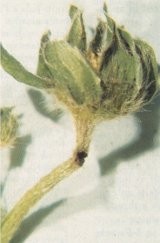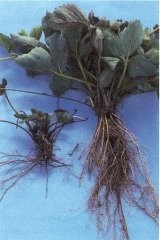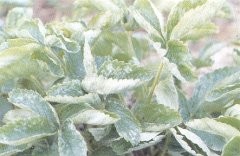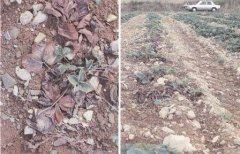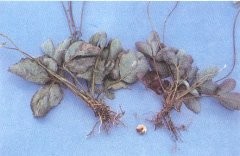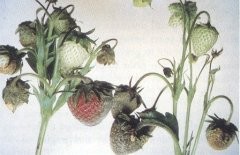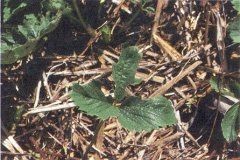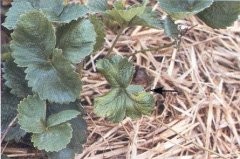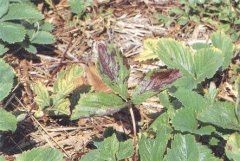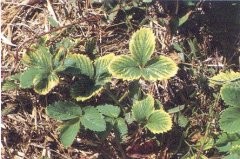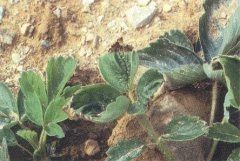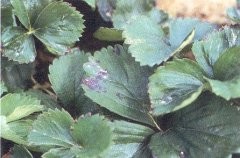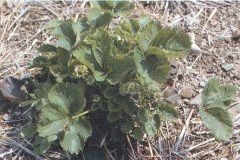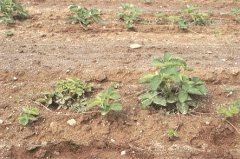Red Stele
Red stele, caused by the fungus Phytophthora fragariae, is favored by heavy, poorly drained soils and cool temperatures. Foliar symptoms, which show up the second year after planting include poor growth, stun-ting, leaf reddening and frequent wilting. The roots often have few rootlets and when cut lengthwise have a brown or red central core (vascular stele) (Fig. 1). This characteristic symptom may only be seen from spring until fruiting and again in the fall. Red stele is most likely to be introduced to a field by infected transplants or machinery which has been used in an in-fested field. Use red stele free certified transplants and thoroughly clean any borrowed equipment before us-ing. Strawberry culture can be carried out in an in-fested field through the use of resistant varieties or fungicide protection.
Strawberry Weevil
The adult strawberry weevil, (Anthonomus signatus), appears just before bloom and can be detected by the small round holes it chews in petals. The adult is brown with a curved snout, half as long as its 2.5 mm (1/10 inch) body. The adult deposits an egg in the bud and clips the stem so it hangs by a thread or falls to the ground (Fig. 2). The larvae, which developes inside the bud, reaches maturity in 3-4 weeks after hatching. The adults emerge in early summer and feed on pollen until they overwinter. Chemical control is available.
Black Root Rot
Black root rot often occurs in older plantings or replanted fields. It is caused by several weakly pathogenic fungi interacting with predisposing factors such as nematode damage, winter damage, frost heave and poorly drained or compacted soils. Plants become weak and stunted causing them to yield poorly. The root system of infected plants are poorly developed with extensive decay (compare diseased to healthy plant, Fig. 3). Roots may have black areas or be com-pletely blackened except for the inner core (vascular stele) which remains white. Symptoms, which are often localized in wet areas of the field, usually show up at fruiting time. Cultural control recommendations in-clude improving soil drainage and structure, the use of rotation with 4 years between strawberry plantings and mulching in winter to prevent frost heave or winter damage. Fumigation prior to planting is also beneficial.
Powdery Mildew
Powdery mildew caused by the fungus, Sphaerotheca macularis may develop in the spring or fall when cool humid weather favors its spread. The characteristic symptom of this disease is upward rolled leaves. These leaves frequently have reddish blotches on their lower surface and in some cases fine, white, hair-like strands of fungus can be seen near large veins, Is (Fig. 4). In the case of severe infection leaves may develop burned margins, then dry up causing plant death. Light infection of leaves in late summer or fall has little effect on fruit production the following year; therefore, fungicide application is not necessary. However, a spring infection of flowers or fruit may result in yield reduction.
Verticillium Wilt
Verticillium wilt can be caused by either of 2 Verticillium fungi. Older leaves of infected plants become discoloured at the margin, curl up and eventually die, while young leaves remain erect, but have a dull green colour (Fig. 5). These symptoms appear in new plan-tings at the time of runnering and in older plantings at fruiting or later. Once introduced to a field, the fungus can survive for many years. The disease is spread by soil adhering to machinery, or in run off water or on infected transplants. Do not follow potatoes, tomatoes or cane fruit with strawberry plantings, as these crops can carry the disease or increase it in the soil. Infested soils can be rejuvenated by fumigation. Some varieties are more tolerant to this disease.
White Grub
The white grub is the larval stage of the June beetle, Popillia japonica. These are large, 1.3-2.5 cm (1/2 inch - I inch) long, thick bodied, white larvae that have 3 pairs of legs near the brown head. When dug up they assume a characteristic "C" position. Adult beetles lay their eggs in sod and the larvae are active for 2 1/2 years in the soil. They feed primarily on grass roots but may seriously damage the roots of other crops. Strawberry plants set out on land previously in sod are most likely to be attacked (Fig. 6). Damaged plants appear unthrifty and often wilt. Do not follow sod with strawberry culture. If white grubs are detected, control is possible prior to planting through use of an insecticide.
Grey Mold
Grey mold caused by the fungus Botrytis cinerea is the most common cause of fruit rot. This disease can be especially damaging during prolonged wet or humid weather at bloom or harvest time. The fungus infects flowers, flower stalks and fruit at all stages of develop-ment causing them to rot and become covered in a dense, grey, fuzzy growth containing the spores of the fungus (Fig. 7). These spores are spread in the field by wind and water. Fruit in contact with soil or other rottin 1 g berries are most commonly infected. Following infection, symptoms may not develop on mature fruit until after harvest, in which case rot may spread within the container. This type of loss may be prevented by only harvesting and packing sound berries. The fungus overwinters in the soil and on plant debris. Control may be obtained through use of fungicide. Do not apply nitrogen during the spring of fruiting year as this promotes a heavy canopy which reduces air circulation and increases fruit rot.
Root Weevil/Crown Borer
Two species of weevils, the black vine weevil, (Otiorhynchus sulcatans) and the strawberry root weevil (Brachyrhinus ovatus) damage strawberry roots and crowns. Both weevils are very common in the woods and around fencerows and are often found in old plantations. The life cycles for these insects are similar. The larvae, which begin feeding in early spring, are small legless grubs approximately 6 mm-12.5 min (1/4-1/2 inch) long depending on the species. Both have dark brown heads and light bodies ranging in colour from white to pink. These grubs eat roots and tunnel in the crowns of strawberry plants causing them to wilt at about the same time as the fruit forms. When a problem is suspected examine the roots for obvious signs of feeding damage and look in the soil from the root area for the grubs. Most grubs pupate in the late spring. In early summer the flightless adults emerge from the soil and begin feeding on foliage at night. Adults of both species notch , leaves (Fig. 8) causing slight damage and adult strawberry root weevils also feed on fruit causing minor injury. Both types of damage, however, are a good indication that larvae are active in the soil. The adults lay eggs which hatch into grubs in 10-15 days. These grubs feed until they o~verwinter in soil. Avoid planting strawberries in succession on the same land. Chemical control is available.
Cyclamen Mite
Cyclamen mites are very small and are best seen with the aid of a hand lens. The live in the crown and unopened leaves. This makes field detection of the mites to be difficult, however the leaf symptoms they cause are very distinctive. Cyclamen mite feeding causes unopened leaves to turn yellow and sometimes fail to open. If these leaves do open, they are often leathery and distorted (Fig. 9). Infested plants are often stunted. These mites may also feed on blossoms causing fruit distortion. When chemical control is warranted it should be applied at renovation time after leaves have been cut off to ensure maximum penetra-tion of miticide into crown.
Scorch
The initial symptoms of scorch caused by the fungus Diplocarpon earliana are indistinguishable from those of leaf spot, which also begins as a small dark red spot. As these spots expand they may form large ir-regular blotches involving most of the leaf (Fig. 10). Similar blotches may occur on berry caps, petioles and runners, but the spots never form light grey centers. The fungus infects plants at all stages of growth. Severe infections result in leaves drying, curling up and appearing scorched. Overwintering and spread are the same as for Common Leaf Spot. Chemical control is available.
Herbicide Damage on Strawberry
Herbicide damage on strawberry initially appears as vivid yellowing of the older leaves. This progresses to marginal burning and eventual drying of the af-fected leaves. Young leaves emerging from the crown often have yellow areas interspersed with the green tissue (Fig. 11). Herbicide sensitivity varies between strawberry varieties, however, herbicide damage is most commonly associated with poor application pro-cedures. When this is the cause of the problem, distinct patterns occur in the field. For example, damage may only occur on uphill grades in the field, or may be associated with boom width or a specific faulty nozzel or may only occur in areas used for turn-ing. The herbicide Simazine may cause damage on higher pH soils.
Tipburn
Tipburn is a complex physiological disorder attributed primarily to moisture stress and large fluctua-tions in temperature. Calcium and boron availability, which are related to soil moisture, have also been im-plicated as casual factors in this disorder. Only very young leaves in the crown, prior to their expansion, are affected. These leaves fail to open properly, are puckered, and have a brown dry area at the tip (Fig. 12). To control this disorder, ensure adequate soil moisture.
Common Leaf Spot
Common leaf spot, caused by the fungus Mycosphaerella fragariae, is favored by humid weather. Infection may occur during spring or fall. The initial symptoms on leaves are small dark red spots which develop light grey centres as they expand (Fig. 13). Similar spots may occur on petioles, fruit stalks, and runners. Spores are produced on the spots and spread to other plants by splashing rain. The fungus overwinters on infected plants. Severe infection may in-crease plant susceptibility to winter injury and reduce yields. Fungicides recommended for fruit rot will also control this disease.
Mutiplier
Mutiplier, aster yellows and green petal are all similar diseases caused by a mycoplasma-like organism which is transmitted by the feeding of a species of leafbopper. Young leaves of plants infected with aster yellows or green petal are small, chlorotic and cupped. Older leaves turn red to brown and then die. Flower petals, stamens and pistils may all be green (Fig. 14). Plants infected with multiplier have similar leaf symp-toms but also have many crowns causing the plant to appear bushy and stunted (Fig. 15). Flowers when pre-sent appear normal and runnering is often profuse. In-spect all new plantings when they start to runner and rogue infected plants.
Tarnisbed Plant Bug
Tarnished plant bug (Lygus Itneolarls) damage to strawberry is one cause of a condition called "button fruit". However, button fruit may also be caused by poor pollination or frost. The adult tarnished plant bug is a shield shaped, brownish, sucking insect approx-imately 5-6 mm (1/5 inch) long. It causes damage by making feeding punctures in the strawberries as they are ripening. Affected fruit remains small and hard. It is usually deformed at the tip causing the seeds to be crowded together. Late maturing varieties of strawber-ries are more susceptible to damage as the insect is more active later in the season. Chemical control is available.
Two-Spotted Spider Mites
Two-spotted spider mites, due to their small size are best seen with the aid of a hand lens. As they are hard to detect on a leaf, they can be better seen by tapping the underside of the leaf over a sheet of white paper to dislodge the mites. Spider mites are found from early June to late fall and feed by sucking the plant sap from leaves. In severe infestations the leaves become bronzed and both growth and fruit yield of the plant are reduced. Hot dry weather can lead to large mite infestations. If more than 15 mites per leaf are detected prior to July 30th, chemical control is war-ranted.
Strawberry Cutworm
The strawberry cutworm (Amphipoea intero-ceanica) causes damage to strawberry plants by feeding on the new growth. The adult moth lays overwintering eggs on field debris. These eggs hatch in the spring producing cream coloured larvae which have two brown stripes down their back. The young larvae move to the strawberry plants where they initially tunnel into leaf stems and fruit stalks. The first sign of damage is the wilting of these attacked leaves. As the larvae grow larger they bore into the crown and this feeding may destroy all of the new growth. About mid-July these lar-vae pupate in the plant debris or soil. The adults, yellow brown moths, emerge in August and begin to lay eggs. Because the moths often lay eggs in the fields where they developed, older strawberry fields tend to receive more damage. Unproductive fields should be fall ploughed to decrease the numbers of overwintering eggs. Chemical control when warranted should be ap-plied before the blossoms open.
Nematodes
Nematodes are very small semi-transparent worms that live in the water film surrounding soil particles, especially in sandy soils. They are invisible to the unaided eye and therefore, can only be detected by laboratory procedures. Nematodes feed in or on the plant roots, making the plant appear unthrifty and bear small fruit. Other root diseases, i.e. Verticillium wilt, may be aggravated by nematode feeding and they have also been implicated as a predisposing factor in black root rot. Since chemical control is expensive it is only warranted when parasitic nematode populations exceed economic thresholds. Your local Agricultural Representative can provide you with the information on nematode sampling procedures.
To obtain chemical control recommendations for any of these strawberry pests, please consult the current edition of the Atlantic Provinces Strawberry Protection Guide or consult your local Agricultural Representative.
Publication Funded by Agriculture Canada and the New Brunswick Department of Agriculture under the Canada/New Brunswick Agri-Food Agreement (1984-1989)

